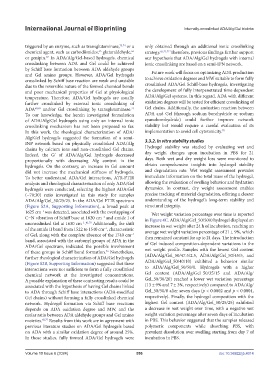Page 564 - IJB-10-6
P. 564
International Journal of Bioprinting Internally-crosslinked ADA/Alg/Gel bioinks
triggered by an enzyme, such as transglutaminase, 73,74 or a only obtained through an additional ionic crosslinking
chemical agent, such as carbodiimides, glutaraldehyde, strategy. 41,73,77 Therefore, previous findings further support
66
65
or genipin. In ADA/Alg/Gel-based hydrogels, chemical our hypothesis that ADA/Alg/Gel hydrogels with internal
67
crosslinking between ADA and Gel could be achieved ionic crosslinking are based on a semi-IPN network.
by Schiff base formation between ADA aldehyde groups
and Gel amino groups. However, ADA/Gel hydrogels Future work will focus on optimizing ADA production
crosslinked by Schiff base reaction are weak and unstable to achieve oxidation degrees and MW suitable to form fully
due to the reversible nature of the formed chemical bonds crosslinked ADA/Gel Schiff-base hydrogels, investigating
and poor mechanical properties of Gel at physiological the development of fully interpenetrated time-dependent
temperature. Therefore, ADA/Gel hydrogels are usually ADA/Alg/Gel systems. In this regard, ADA with different
further crosslinked by external ionic crosslinking of oxidation degrees will be tested for efficient crosslinking of
ADA 68,69 and/or Gel crosslinking by transglutaminase. Gel chains. Additionally, the amination reaction between
73
To our knowledge, the herein investigated formulation ADA and Gel (through sodium borohydride or sodium
of ADA/Alg/Gel hydrogels using only an internal ionic cyanoborohydride) could further improve network
crosslinking mechanism has not been proposed so far. stability but would require a careful evaluation of its
In this work, the rheological characterization of ADA/ implementation to avoid cell cytotoxicity. 78
Alg/Gel hydrogels suggested the formation of a semi-
INP network based on physically crosslinked ADA/Alg 3.3.2. In vitro stability studies
chains by calcium ions and non-crosslinked Gel chains. Hydrogel stability was studied by evaluating wet and
Indeed, the G′ of ADA/Alg/Gel hydrogels decreased dry weight changes upon incubation in PBS for 21
proportionally with decreasing Alg content in the days. Both wet and dry weight loss were monitored to
hydrogels. On the contrary, an increase in Gel amount obtain comprehensive insights into hydrogel stability
did not increase the mechanical stiffness of hydrogels. and degradation rate. Wet weight assessment provides
To better understand ADA/Gel interactions, ATR-FTIR immediate information on the total mass of the hydrogel,
analysis and rheological characterization of only ADA/Gel allowing the evaluation of swelling behavior and hydration
hydrogels were conducted, selecting the highest ADA:Gel dynamics. In contrast, dry weight assessment enables
(~70:30) ratio investigated in this study for samples precise tracking of material degradation, offering a clearer
ADA/Alg/Gel_50/25/25. In the ADA/Gel FTIR spectrum understanding of the hydrogel’s long-term stability and
(Figure S2A, Supporting Information), a broad peak at structural integrity.
1625 cm was detected, associated with the overlapping of Wet weight variation percentage over time is reported
−1
C=N vibration of Schiff base at 1620 cm and amide I of in Figure 4C. ADA/Alg/Gel_50/50/0 hydrogel displayed an
−1
uncrosslinked Gel at 1630 cm . Additionally, the shift increase in wet weight after 24 h of incubation, reaching an
−1 41,75
of the amide II band from 1522 to 1540 cm , characteristic average wet weight variation percentage of 21 ± 9%, which
−1
of Gel, along with the complete absence of the 1740 cm then remained constant for up to 21 days. The introduction
−1
band, associated with the carbonyl groups of ADA in the of Gel induced composition-dependent variations in the
ADA/Gel spectrum, indicated the possible involvement
of these groups in Schiff bond formation. Nonetheless, wet weight profile. Samples with the lowest Gel content
76
further rheological characterization of ADA/Gel hydrogels (ADA/Alg/Gel_50/47.5/2.5, ADA/Alg/Gel_50/45/5, and
(Figure S2B, Supporting Information) suggested that these ADA/Alg/Gel_50/40/10) exhibited a behavior similar
interactions were not sufficient to form a fully crosslinked to ADA/Alg/Gel_50/50/0. Hydrogels with a higher
chemical network at the investigated concentrations. Gel content (ADA/Alg/Gel_50/35/15 and ADA/Alg/
A possible explanation of these contrasting results could be Gel_50/30/20) reached a lower wet variation percentage
associated with the hypothesis of having Gel chains linked (13 ± 9% and 7 ± 3%, respectively) compared to ADA/Alg/
to ADA through Schiff base interactions (ADA-modified Gel_50/50/0 after seven days (p < 0.0002 and p < 0.0001,
Gel chains) without forming a fully crosslinked chemical respectively). Finally, the hydrogel composition with the
network. Hydrogel formation via Schiff base reactions highest Gel content (ADA/Alg/Gel_50/25/25) exhibited
depends on ADA oxidation degree and MW, and the a decrease in wet weight over time, with a negative wet
molar ratio between ADA aldehyde groups and Gel amino weight variation percentage after seven days of incubation
moieties. 68,77 Results from this work are in agreement with in PBS. This behavior suggested that the samples released
previous literature studies on ADA/Gel hydrogels based polymeric components while absorbing PBS, with
on ADA with a similar oxidation degree of around 25%. prevalent dissolution over swelling starting from day 7 of
In those studies, fully formed ADA/Gel hydrogels were incubation in PBS.
Volume 10 Issue 6 (2024) 556 doi: 10.36922/ijb.4014

